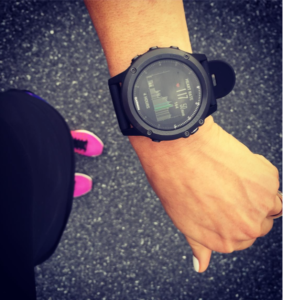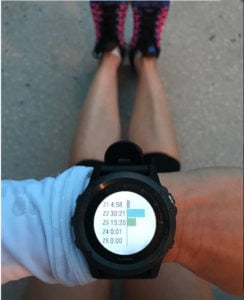Get In The Zone: How Train Using Heart Rate
Please enjoy the following guest blog post from Ambassador @knead_to_cook
Heart rate training. What is it? Who should do it? And why?
There are so many articles and books out there on heart rate training. I wanted to give my perspective on the training method and my personal experience. I started training in this method just over 2 years ago. I had never heard of it prior to speaking to an ultra marathoner friend who was a advocate. I had, at the time, just come off my second marathon where my heart rate had exceeded 244 bpm. Insanely high. Cardiologist suggested only running 2 or 3 – 30 minute runs per week. I was diagnosed with a prolapse mitral valve and cardiac arrhythmia. Concerns but nothing that would halt my running efforts.
After speaking to my friend, I did a ton of research. There is simply a plethora of data out there. I wanted to keep it simple and go with the basics. I started with calculating my max heart rate which was simple – take 220 minus your age. Okay, easy enough. My max rate is 220-44= 176. If you have a Garmin running watch, it sets up your zones for you once you input your age, gender etc.
Like I said, I kept it really simple – Initially, I didn’t worry about what zone I was training in but only watched my max number and kept it under (or attempted to) 176. The other levels are as follows for clarification:
Zone 1 is 60-70% of threshold heart rate (the 220 minus your age). This is a very light intensity effort. Think nice walking pace where you can carry on a conversation.
Zone 2 is 70-80% of threshold heart rate. Think of this as a warm-up or cool-down run. Easy conversation pace as well.
Zone 3 is 80-90% of threshold heart rate. This is a long run type of effort. Breathing a bit harder here but I would say comfortable.
Zone 4 is 90-100% of threshold heart rate. Harder intensity effort. You can reply in single word responses. Tempo type of run. Raising lactate threshold levels.
Zone 5 is 100-110% of threshold heart rate. Think of sprinting to the finish line. Cannot hold a conversation.
Yes, this is admittedly a lot of numbers but once you look at them they all make sense. Aerobic activity moving up to anaerobic. You can also see the logic in training efforts and days to recover. Easier runs don’t require as long to recover as a zone 4 or 5 run would need.
I tackled running with one goal in the beginning – stay in zone 4. I would run and inevitably my untrained heart would spike into the 200’s. I would immediately stop, walk and drink my fuel. I would start back at it again and repeat this as necessary. Did it take time, yes. Were some days easier than others, of course. Running slower helped but other factors were hydration and weather. Hotter, more humid days made it difficult posing a struggle for me till this day. If I hadn’t hydrated properly the day before, I noticed a substantial difference. It took time. How much time? 6-12 months. Yes, it takes a big effort and a lot of work.
So what was the ultimate benefit? After several months I started to notice that my heart rate was staying within zone 3 and 4. I was able to run what seemed like forever with minimal recovery. No muscle soreness. I felt great. I had trained for 2 marathons and post 20 mile training runs I would be laid up in a chair with a book for most of the day. Sore and fatigued. But now I was training for my first and second ultra marathons. I would run 24, 28 or even 32 mile runs and felt great the whole day. I mean, maybe some fatigue in my legs or a sore knee (I have bad knees) but my day would march on without me resting up all day long. I run very early in the morning, 3:45 or 4a and be home by 8 or 9 at the latest with a full day ahead of me. I did this day in and day out.
Now I realize that most people have no desire to spend hours running or training for an ultra marathon but I wanted to share my story. Personally, I had no desire to even run a third marathon but I discovered a passion and love that captivated me. I pushed myself further and further to see what I was capable of. I ran my first ultra and wanted to do more. I ran my best runs on random Thursdays. I never dreamed that I would run 50k’s as a training run. If it weren’t for my heart rate training, I would never embraced this journey. Training my heart also trained my mind.
From the beginning of my journey of hr training, I stuck with running long runs at zone 3 or 4. If you wish to build up speed or return to it, using your current training program, aim to hit your hr targets for those specific runs. So on tempo workouts aim to keep your rate in zone 4. For your long training run days, aim for zone 3 so on and so forth.
Anyone can benefit from heart rate training but it is certainly a lengthy commitment. It does knock you down, pace-wise, and then you build up on a solid foundation. My best suggestion is to keep it really simple and not get bogged down with all of the zones. Have a target or a max number in mind and focus on that. I do recommend a running watch with heart rate monitor built-in or a heart rate monitor strap. These tools provide you immediate data on your watch you can watch as you run.
Wishing you happy & healthy running… until next time!
The post Get In The Zone: How Train Using Heart Rate appeared first on Garmin Blog.
Sample Block Quote
Praesent vestibulum congue tellus at fringilla. Curabitur vitae semper sem, eu convallis est. Cras felis nunc commodo loremous convallis vitae interdum non nisl. Maecenas ac est sit amet augue pharetra convallis nec danos.
Sample Paragraph Text
Praesent vestibulum congue tellus at fringilla. Curabitur vitae semper sem, eu convallis est. Cras felis nunc commodo eu convallis vitae interdum non nisl. Maecenas ac est sit amet augue pharetra convallis nec danos dui.
Cras suscipit quam et turpis eleifend vitae malesuada magna congue. Damus id ullamcorper neque. Sed vitae mi a mi pretium aliquet ac sed elitos. Pellentesque nulla eros accumsan quis justo at tincidunt lobortis denimes loremous. Suspendisse vestibulum lectus in lectus volutpat, ut dapibus purus pulvinar. Vestibulum sit amet auctor ipsum.



